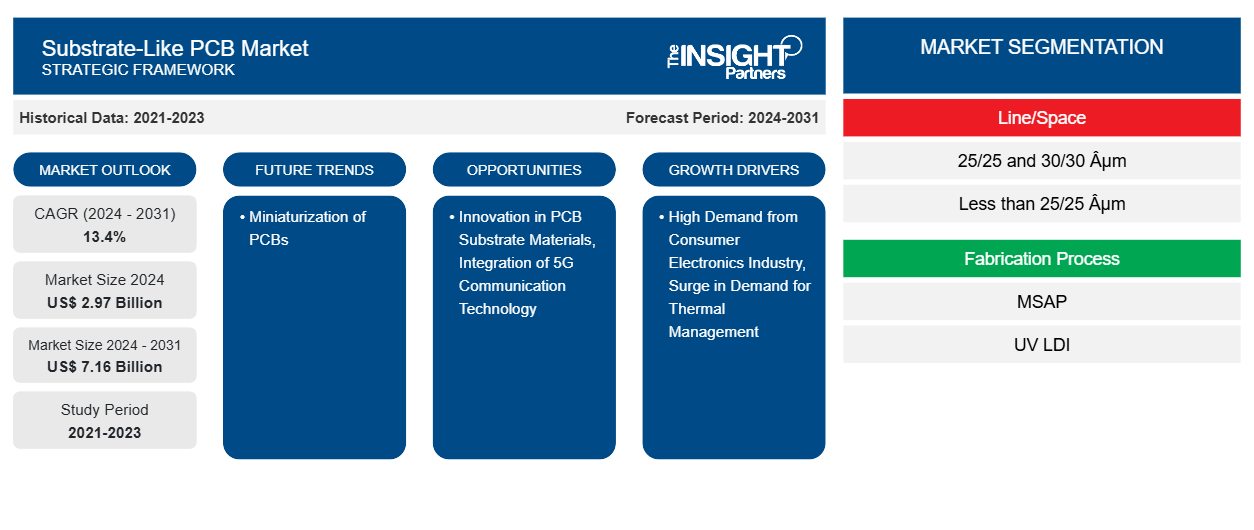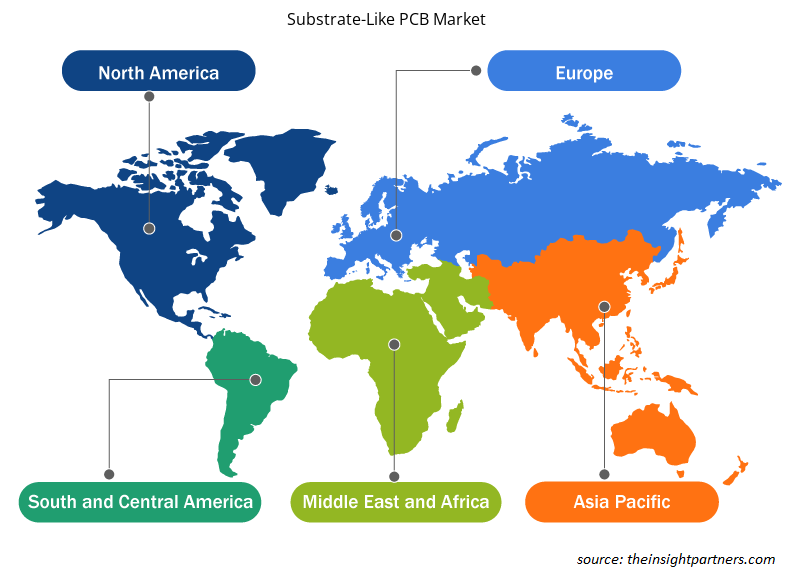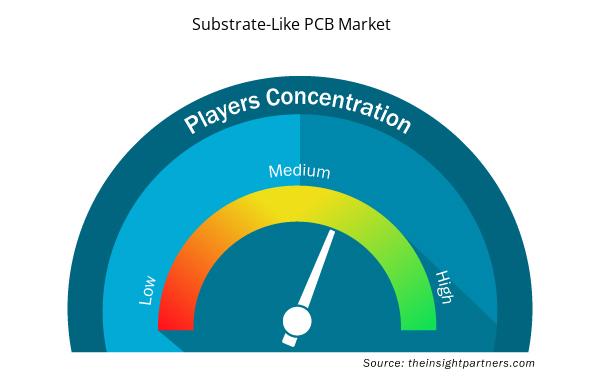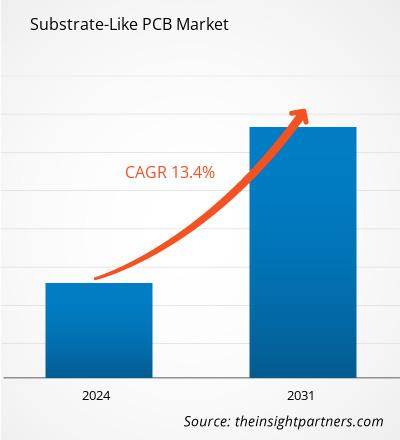预计到 2031 年,基板类 PCB 市场规模将从 2024 年的 29.7 亿美元增至 71.6 亿美元。预计 2024-2031 年期间市场复合年增长率将达到 13.4%。PCB 的小型化可能会在未来几年为市场带来新的趋势。
类基板 PCB 市场分析
类基板 PCB(SLP 或类基板印刷电路板)具有与半导体基板相似的特性。该 PCB 专为先进的 IC 封装和超高密度应用而开发。类基板 PCB 结合了传统电路板和半导体基板的特性,可满足消费者对现代电子产品的需求。这些 PCB 被高度整合到智能手机、可穿戴设备、计算机、制动系统、ADAS 和其他先进消费电子产品等高性能应用中,以提高其性能。类基板 PCB 提供高密度、高性能、紧凑的设计,能够满足当前小型化电子产品的需求。此外,类基板 PCB 提供的显着优势,例如热管理、高密度互连和通过减少电磁干扰 (EMI) 实现的信号完整性,增加了它们在行业中的应用。消费电子、汽车、医疗、工业、航空航天和其他行业正在使用类基板 PCB 来提高设备和系统的电气性能,从而推动市场发展。
类基板 PCB 市场概览
消费电子行业需求的增长、客户对热管理的需求、汽车行业的不断扩张以及制造商对制造电动汽车和自动驾驶汽车的关注是推动类基板 PCB 市场发展的几个重要因素。此外,对智能手机、可穿戴设备和无线技术的投资不断增加,推动了全球对类基板 PCB 的需求。此外,PCB 基板中使用的创新材料,例如环氧树脂、聚四氟乙烯 (PTFE)、玻璃纤维编织、柔性聚合物和其他降低热量的介电和绝缘材料,以及 5G 通信技术在商业模式中的集成,是预计在预测期内为类基板 PCB 市场增长创造机会的几个因素。此外,研发活动的增加、PCB 的小型化以及工业对下一代 PCB 的需求鼓励制造商专注于开发微型 PCB,从而促进类基板 PCB 市场的增长。
定制此报告以满足您的需求
您可以免费定制任何报告,包括本报告的部分内容、国家级分析、Excel 数据包,以及为初创企业和大学提供优惠和折扣
类基板 PCB 市场:

- 获取此报告的关键市场趋势。这个免费样品将包括数据分析,从市场趋势到估计和预测。
类基板 PCB 市场驱动因素和机遇
热管理需求激增
热管理是裸 PCB 和组装层面日益严重的问题,尤其是在高功率和高电压应用中,对更好的传热和冷却解决方案的要求至关重要。基板类 PCB 采用聚酰亚胺、双马来酰亚胺三嗪 (BT) 树脂和玻璃纤维增强环氧树脂 (FR-4) 制成,这些材料比其他电路板材料具有更好的导热性。许多行业广泛使用基板类 PCB 来改善电子元件的散热,从而提高导热性并增加设备可靠性和使用寿命。例如:
• 在消费电子行业,基板类 PCB 用于高端智能手机、笔记本电脑和游戏机,以减少处理器、图形处理单元 (GPU) 和电源模块的热量。这些设备的内部结构变得越来越复杂,因此必须控制强大芯片产生的热量并保持其性能和耐用性。例如,基板类 PCB 用于高性能智能手机,以有效调节处理器产生的热量,确保设备即使在用于视频流和游戏时也能保持凉爽。
• 电动汽车 (EV) 和自动驾驶系统高度依赖基板类 PCB 来保持其电子设备的热稳定性,尤其是电力电子设备和电池管理系统。电动汽车中的冷却电源模块对于电池系统的安全性和性能至关重要。此外,在汽车行业,基板类 PCB 用于电动汽车中的电池充电器、电源逆变器和电机控制器的热管理。
• 在电信行业,一些操作需要高频传输,其中功率放大器会产生大量热量,这增加了对基板类 PCB 的需求,以改善热管理。这在基站和通信中心尤为重要,因为停机可能导致严重的服务中断。例如,5G 网络的基站需要高效的热管理来处理功率放大器和高频组件。
• 在医疗行业,热管理对于提高设备性能和患者安全至关重要。基板类 PCB 为在操作过程中保持敏感医疗设备低温提供了可靠的选择。例如,先进的诊断设备(如磁共振成像 (MRI) 机和便携式医疗设备)使用基板类 PCB 进行热控制,以避免过热并延长设备寿命。
基板类 PCB 为工业应用提供了显著的优势,例如可以实现产品小型化、增强性能以及改善热性能和机械性能。这增加了其在消费电子、汽车、医疗、电信、医疗和航空航天等各个行业的需求。因此,热管理需求的激增推动了基板类 PCB 市场的增长。
PCB 基板材料的创新
陶瓷等传统材料一直是 PCB 的基础。最近,PCB 已成为电子行业创新的中心。在这个充满活力的行业中,环氧树脂、聚四氟乙烯 (PTFE)、玻璃纤维编织物、柔性聚合物和其他介电和绝缘材料等 PCB 基板已从传统材料转变为纳米复合材料。这些材料为 PCB 的组件提供机械支撑和电气绝缘。PCB 基板是安装导电路线和电子元件的基础,支持允许电脉冲在整个电路中流动的导电迹线。随着电子制造商专注于开发先进设备,PCB 制造商对 PCB 基板的采用正在增加。下面提到了其中一些创新材料:
• 高频材料:聚四氟乙烯 (PTFE) 和陶瓷填充碳氢化合物等高频材料代表着 PCB 基板发展的重要一步。这些材料可最大程度地减少信号损失并提高信号完整性,这对于以更高频率发送数据至关重要。采用这些材料可以创建能够处理下一代无线通信和其他高频应用中使用的高数据速率的 PCB。
• 柔性和刚柔结合基板:柔性和刚柔结合基板(通常由聚酰亚胺制成)的引入使 PCB 能够弯曲或贴合非平面表面,为可穿戴设备创造了潜在的应用空间。刚柔结合基板将柔性和刚性材料结合在一块板上,实现了灵活性和结构完整性之间的平衡。这项发明正在重塑产品设计,从而可以开发可折叠智能手机、柔性显示器和其他小型电子产品。
• 纳米复合材料:纳米复合材料通过在基础材料中添加纳米颗粒来改善 PCB 基板。这些纳米颗粒通常以碳为基础,通过为 PCB 提供更好的性能、更小的尺寸和更高的可靠性来提高机械强度、热导率和电气特性。此外,纳米复合材料在航空航天和医疗设备应用中特别有用,因为这些应用的尺寸和重量至关重要。随着材料技术的进步,纳米复合材料在 PCB 基板上的集成量激增,这进一步提高了电子设备的效率和性能。
PCB 基板是电子元件精确集成的框架,可用于制造为各种电子设备(包括智能手机、平板电脑和工业机器)供电的复杂电路。因此,PCB 基板材料的创新有望在预测期内为基板类 PCB 市场增长创造机会。
类基板 PCB 市场报告细分分析
有助于得出类基板 PCB 市场分析的关键部分是线路/空间、制造工艺和应用。
- 根据线宽/间距,基板类 PCB 市场分为 25/25 和 30/30 µm 以及小于 25/25 µm。25/25 和 30/30 µm 部分在 2024 年占据了较大的市场份额。
- 根据制造工艺,基板类 PCB 市场分为 MSAP 和 UV LDI。MSAP 部分在 2024 年占据了最大的市场份额。
- 根据应用,基板类 PCB 市场细分为消费电子、汽车、工业、医疗等。其他部分在 2024 年占据了最大的市场份额。
基板类 PCB 市场份额按地区分析
载板类PCB市场报告的地理范围主要分为五个区域:北美、亚太、欧洲、中东和非洲、南美和中美。
2023 年,亚太地区占据了相当大的市场份额。5G 网络基础设施的发展和行业对多层 PCB 的需求鼓励市场参与者增加产量并开发定制 PCB 以满足客户的动态需求。政府的举措和对提高与基板类 PCB 优势相关的认识的关注正在推动市场增长。例如,2022 年 4 月,中国知识产权局授予深圳市金旺电子有限公司中国专利优秀奖,以表彰其开发了多层 PCB 生产方法和多层 PCB 板。这些多层 PCB 板通常用于 5G 基站、数据存储、服务器、交换路由器、卫星系统、工业控制和医疗设备。此外,工业对多层 PCB 的需求不断增长,鼓励深圳市金旺电子有限公司生产和制造具有显着工业化效益的各种多层产品。
由于政府和市场参与者更加注重提升电子制造业,预计韩国基板类 PCB 市场将在预测期内扩大。例如,IPC International, Inc. 于 2024 年 10 月 29 日在首尔举办了第二届年度 IPC 韩国电子标准和技术研讨会 PC K-FEST 2024。该研讨会旨在应对电子制造业的挑战,展示 IPC 标准如何提高制造性能和质量。此外,市场参与者正专注于扩大其在韩国的业务以吸引新客户,这很可能在预测期内为市场创造机会。例如,2024 年 1 月 6 日,小米推出了一家新子公司和一系列智能设备,包括智能手机、可穿戴设备、电视、移动电源和机器人吸尘器,以扩大其在韩国的影响力。这些产品支持小米满足从经济实惠到高端设备的各种消费者需求。随着电子设备变得越来越紧凑和微型,对更小、更高效的电路板的需求也在增加。智能手机、平板电脑、可穿戴设备和物联网设备均使用基板类 PCB 进行高密度封装。
类基板 PCB 市场区域洞察
Insight Partners 的分析师已详尽解释了预测期内影响类基板 PCB 市场的区域趋势和因素。本节还讨论了北美、欧洲、亚太地区、中东和非洲以及南美和中美洲的类基板 PCB 市场细分和地理位置。

- 获取基板类 PCB 市场的区域特定数据
类基板 PCB 市场报告范围
| 报告属性 | 细节 |
|---|---|
| 2024 年的市场规模 | 29.7亿美元 |
| 2031 年市场规模 | 71.6亿美元 |
| 全球复合年增长率(2024 - 2031) | 13.4% |
| 史料 | 2021-2023 |
| 预测期 | 2024-2031 |
| 涵盖的领域 | 按线/间距
|
| 覆盖地区和国家 | 北美
|
| 市场领导者和主要公司简介 |
|
类基板 PCB 市场参与者密度:了解其对业务动态的影响
基板类 PCB 市场正在快速增长,这得益于终端用户需求的不断增长,而这些需求又源于消费者偏好的不断变化、技术进步以及对产品优势的认识不断提高等因素。随着需求的增加,企业正在扩大其产品范围,进行创新以满足消费者的需求,并利用新兴趋势,从而进一步推动市场增长。
市场参与者密度是指在特定市场或行业内运营的企业或公司的分布情况。它表明在给定市场空间中,相对于其规模或总市场价值,有多少竞争对手(市场参与者)存在。
在类基板 PCB 市场运营的主要公司有:
- 华通制造有限公司
- 景硕互联科技
- 三星电机株式会社
- AT&S 奥地利技术与系统技术股份公司
- 真鼎科技集团科技控股有限公司
- TTM 科技公司
免责声明:上面列出的公司没有按照任何特定顺序排列。

- 获取类基板 PCB 市场主要参与者概览
类基板 PCB 市场新闻及最新发展
通过收集一手和二手研究的定性和定量数据来评估类基板 PCB 市场,其中包括重要的公司出版物、协会数据和数据库。下面列出了类基板 PCB 市场的一些发展情况:
- ICAPE 集团宣布签署合同,收购日本 NTW 集团 100% 的资本,该集团专门从事亚洲 PCB 分销。通过接入 ICAPE 集团的全球物流平台,NTW 可以为客户提供新服务,扩大产品范围,从而提高盈利增长。(来源:ICAPE 集团,新闻稿,2024 年 9 月)
- 中国知识产权局公布了第二十三届中国专利奖评审结果,景旺电子的多层PCB生产方法及多层PCB板荣获中国专利优秀奖。中国专利奖由中国知识产权局和世界知识产权组织共同主办。(来源:深圳市景旺电子有限公司,新闻稿,2022年4月)
类基板 PCB 市场报告覆盖范围和交付成果
“类基板 PCB 市场规模和预测(2021-2031 年)”报告对以下领域进行了详细的市场分析:
- 范围内涵盖的所有关键细分市场的全球、区域和国家层面的类基板 PCB 市场规模和预测
- 类基板 PCB 市场趋势,以及驱动因素、限制因素和关键机遇等市场动态
- 详细的 PEST 和 SWOT 分析
- 类基板 PCB 市场分析涵盖关键市场趋势、全球和区域框架、主要参与者、法规和最新市场发展
- 行业格局和竞争分析,涵盖市场集中度、热点图分析、知名企业以及基板类 PCB 市场的最新发展
- 详细的公司简介
- 历史分析(2 年)、基准年、预测(7 年)及复合年增长率
- PEST 和 SWOT 分析
- 市场规模价值/数量 - 全球、区域、国家
- 行业和竞争格局
- Excel 数据集


- Small Internal Combustion Engine Market
- Quantitative Structure-Activity Relationship (QSAR) Market
- Oxy-fuel Combustion Technology Market
- Dropshipping Market
- Nitrogenous Fertilizer Market
- Embolization Devices Market
- Blood Collection Devices Market
- Adaptive Traffic Control System Market
- Intradermal Injection Market
- Sexual Wellness Market

Report Coverage
Revenue forecast, Company Analysis, Industry landscape, Growth factors, and Trends

Segment Covered
This text is related
to segments covered.

Regional Scope
North America, Europe, Asia Pacific, Middle East & Africa, South & Central America

Country Scope
This text is related
to country scope.
常见问题
The global substrate-like PCBs market is estimated to register a CAGR of 13.4% during the forecast period 2024–2031.
The global substrate-like PCBs market is expected to reach US$ 7.16 billion by 2031.
Miniaturization of PCBs to play a significant role in the global substrate-like PCBs market in the coming years.
The key players holding majority shares in the global substrate-like PCBs market are Compeq Manufacturing Co., Ltd., Kinsus Interconnect Technology, Samsung Electro-Mechanics Co Ltd, AT & S Austria Technologie & Systemtechnik Aktiengesellschaft, Zhen Ding Tech. Group Technology Holding Limited, TTM Technologies Inc., Korea Circuit, Shenzhen Kinwong Electronic Co., Ltd., ICAPE Holding SA, and LG Innotek Co Ltd.
High demand from consumer electronics industry and surge in demand for thermal management are the major factors that propel the global substrate-like PCBs market.
Asia Pacific dominated the substrate-like PCBs market in 2024.
Trends and growth analysis reports related to Electronics and Semiconductor : READ MORE..
The List of Companies - Substrate-Like PCB Market
- Compeq Manufacturing Co., Ltd.
- Kinsus Interconnect Technology
- Samsung Electro-Mechanics Co Ltd
- AT & S Austria Technologie & Systemtechnik Aktiengesellschaft
- Zhen Ding Tech. Group Technology Holding Limited
- TTM Technologies Inc.
- Korea Circuit
- Shenzhen Kinwong Electronic Co., Ltd.
- ICAPE Holding SA
- LG Innotek Co Ltd
The Insight Partners performs research in 4 major stages: Data Collection & Secondary Research, Primary Research, Data Analysis and Data Triangulation & Final Review.
- Data Collection and Secondary Research:
As a market research and consulting firm operating from a decade, we have published and advised several client across the globe. First step for any study will start with an assessment of currently available data and insights from existing reports. Further, historical and current market information is collected from Investor Presentations, Annual Reports, SEC Filings, etc., and other information related to company’s performance and market positioning are gathered from Paid Databases (Factiva, Hoovers, and Reuters) and various other publications available in public domain.
Several associations trade associates, technical forums, institutes, societies and organization are accessed to gain technical as well as market related insights through their publications such as research papers, blogs and press releases related to the studies are referred to get cues about the market. Further, white papers, journals, magazines, and other news articles published in last 3 years are scrutinized and analyzed to understand the current market trends.
- Primary Research:
The primarily interview analysis comprise of data obtained from industry participants interview and answers to survey questions gathered by in-house primary team.
For primary research, interviews are conducted with industry experts/CEOs/Marketing Managers/VPs/Subject Matter Experts from both demand and supply side to get a 360-degree view of the market. The primary team conducts several interviews based on the complexity of the markets to understand the various market trends and dynamics which makes research more credible and precise.
A typical research interview fulfils the following functions:
- Provides first-hand information on the market size, market trends, growth trends, competitive landscape, and outlook
- Validates and strengthens in-house secondary research findings
- Develops the analysis team’s expertise and market understanding
Primary research involves email interactions and telephone interviews for each market, category, segment, and sub-segment across geographies. The participants who typically take part in such a process include, but are not limited to:
- Industry participants: VPs, business development managers, market intelligence managers and national sales managers
- Outside experts: Valuation experts, research analysts and key opinion leaders specializing in the electronics and semiconductor industry.
Below is the breakup of our primary respondents by company, designation, and region:

Once we receive the confirmation from primary research sources or primary respondents, we finalize the base year market estimation and forecast the data as per the macroeconomic and microeconomic factors assessed during data collection.
- Data Analysis:
Once data is validated through both secondary as well as primary respondents, we finalize the market estimations by hypothesis formulation and factor analysis at regional and country level.
- Macro-Economic Factor Analysis:
We analyse macroeconomic indicators such the gross domestic product (GDP), increase in the demand for goods and services across industries, technological advancement, regional economic growth, governmental policies, the influence of COVID-19, PEST analysis, and other aspects. This analysis aids in setting benchmarks for various nations/regions and approximating market splits. Additionally, the general trend of the aforementioned components aid in determining the market's development possibilities.
- Country Level Data:
Various factors that are especially aligned to the country are taken into account to determine the market size for a certain area and country, including the presence of vendors, such as headquarters and offices, the country's GDP, demand patterns, and industry growth. To comprehend the market dynamics for the nation, a number of growth variables, inhibitors, application areas, and current market trends are researched. The aforementioned elements aid in determining the country's overall market's growth potential.
- Company Profile:
The “Table of Contents” is formulated by listing and analyzing more than 25 - 30 companies operating in the market ecosystem across geographies. However, we profile only 10 companies as a standard practice in our syndicate reports. These 10 companies comprise leading, emerging, and regional players. Nonetheless, our analysis is not restricted to the 10 listed companies, we also analyze other companies present in the market to develop a holistic view and understand the prevailing trends. The “Company Profiles” section in the report covers key facts, business description, products & services, financial information, SWOT analysis, and key developments. The financial information presented is extracted from the annual reports and official documents of the publicly listed companies. Upon collecting the information for the sections of respective companies, we verify them via various primary sources and then compile the data in respective company profiles. The company level information helps us in deriving the base number as well as in forecasting the market size.
- Developing Base Number:
Aggregation of sales statistics (2020-2022) and macro-economic factor, and other secondary and primary research insights are utilized to arrive at base number and related market shares for 2022. The data gaps are identified in this step and relevant market data is analyzed, collected from paid primary interviews or databases. On finalizing the base year market size, forecasts are developed on the basis of macro-economic, industry and market growth factors and company level analysis.
- Data Triangulation and Final Review:
The market findings and base year market size calculations are validated from supply as well as demand side. Demand side validations are based on macro-economic factor analysis and benchmarks for respective regions and countries. In case of supply side validations, revenues of major companies are estimated (in case not available) based on industry benchmark, approximate number of employees, product portfolio, and primary interviews revenues are gathered. Further revenue from target product/service segment is assessed to avoid overshooting of market statistics. In case of heavy deviations between supply and demand side values, all thes steps are repeated to achieve synchronization.
We follow an iterative model, wherein we share our research findings with Subject Matter Experts (SME’s) and Key Opinion Leaders (KOLs) until consensus view of the market is not formulated – this model negates any drastic deviation in the opinions of experts. Only validated and universally acceptable research findings are quoted in our reports.
We have important check points that we use to validate our research findings – which we call – data triangulation, where we validate the information, we generate from secondary sources with primary interviews and then we re-validate with our internal data bases and Subject matter experts. This comprehensive model enables us to deliver high quality, reliable data in shortest possible time.

 获取此报告的免费样本
获取此报告的免费样本